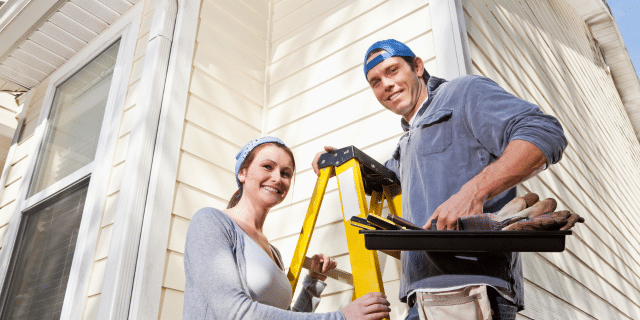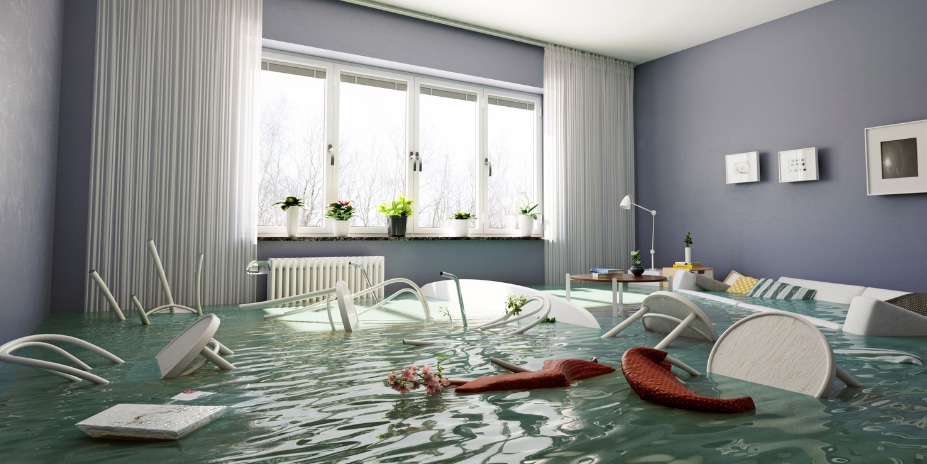
by California Casualty | Helpful Tips, Homeowners Insurance Info |
Imagine catching a leaky roof before it becomes a flood or spotting a crack in the foundation before it threatens your home’s stability. A yearly home maintenance inspection empowers you to identify small issues early, saving you time, money, and headaches. With a simple checklist and a little effort, you can keep your home in tip-top shape and avoid costly surprises down the road. Use this list as your guide to stay ahead of potential problems.
Gather Your Supplies
- Binoculars (for roof inspection)
- Flashlight (for inspecting dimly lit spaces)
- Ladder (to reach roofs, gutters, and higher areas)
- Electrical tester (to check outlets and circuits; ask your local hardware store for guidance)
- Moisture meter (to detect hidden dampness)
- Screwdriver set (for tightening fixtures and covers)
- Smartphone or camera (to document areas of concern)
- Notepad and pen (for notetaking and listing repairs that need to be made)
- Conduct a visual inspection of your roof from the ground with binoculars. If necessary, climb the ladder to get a closer look.
- Look for missing or damaged shingles, rusted or damaged flashing around vents, chimneys, or skylights.
- Check for signs of moss or algae and debris accumulation.
- Clear any debris from clogged gutters and downspouts. Check that your gutters, gutter guards, and downspouts are in good condition.
- Make sure the downspouts direct water away from your foundation.
- Look under your roof from inside the attic for water stains, wet insulation, or visible leaks.
Exterior: Siding, Windows, and Doors
- Inspect siding for cracks, warping, or peeling paint.
- Look for crumbling stucco, brick, or loose mortar.
- Check where two materials (like siding and brick) meet. These areas are prone to water infiltration.
- Examine caulking and weather stripping for cracks or gaps. Check seals for drafts or moisture buildup.
- Test windows and doors to ensure they open and close smoothly without sticking.
Foundation and Grading
- Walk the perimeter of your home. Check that the ground slopes away from the foundation to prevent puddles of standing water.
- Look for cracks, bulges, or other structural concerns. Small hairline cracks are normal, but large gaps or shifts require professional attention.
- Monitor retaining walls for signs of leaning or crumbling.
Walls, Ceilings, and Floors
- Inspect interior walls and ceilings for discoloration, bubbling paint, or peeling wallpaper.
- Look for cracks above doors or windows, which could indicate the foundation settling.
- Check floors for unevenness, soft spots, or squeaks.
- Look for stains or damage that may signal underlying issues.
- Pay extra attention to beams, joists, and trusses for structural damage.
Basement, Attic, and Crawl Spaces
- Look for signs of moisture or mold. Check walls and floors for dampness or mildew.
- Ensure attic insulation is intact and not blocking vents.
- Make sure there are no signs of pests.
- Examine floor joists and roof supports for sagging, cracking, or insect damage.
- Verify that crawl spaces are free of standing water and adequately ventilated.
HVAC System
- Test heating and cooling systems. Turn them on to check for unusual sounds or odors.
- Replace air filters and clean vent covers.
- Inspect the furnace and air conditioning units for rust, leaks, or wear.
- Verify that bathroom and kitchen exhaust fans vent to the exterior and are free of debris.
Electrical System
- Test outlets with an electrical tester.
- Inspect the electrical panel for scorch marks, loose wires, or burning smells.
- Replace batteries in smoke and carbon monoxide detectors and test that they work.
- Secure loose outlet covers and check visible wiring for fraying or damage.
Plumbing System
- Check faucets, showerheads, and toilets for leaks, drips or corrosion.
- Check for loose handles or connections.
- Test water pressure and observe how quickly sinks and tubs drain.
- Inspect under sinks and around toilets for water stains, dampness, or mold.
Appliances
- Garbage disposal: Clean thoroughly and check for blockages.
- Water heater: Flush to remove sediment and extend its lifespan.
- Refrigerator and freezer: Clean coils and empty drip trays.
- Fire extinguishers: Check the pressure gauge and expiration date.
If you’re not comfortable doing a home inspection yourself, consider hiring a professional home inspector. This typically costs about the same as when you hire an inspector to check out a home you’re going to buy. When you are ready to make repairs, and you cannot do them yourself, make sure to hire a reputable contractor.
Finally, your home is one of your greatest investments. Be sure to protect it with the right insurance for added peace of mind.
This article is furnished by California Casualty, providing auto and home insurance to educators, law enforcement officers, firefighters, and nurses. Get a quote at 1.866.704.8614 or www.calcas.com.

by California Casualty | Calcas Connection, Finances, Homeowners Insurance Info, Safety |
Flooding is one of the costliest natural disasters in the United States, with the potential to impact millions of homes and communities. While FEMA and other agencies provide flood maps to help homeowners understand their risk levels, many of these maps are outdated, leading to a false sense of security for people who live in areas not designated as high-risk. Floods, however, aren’t limited to high-risk zones; even areas classified as low-risk are vulnerable under certain conditions. For these reasons, it’s vital to consider flood insurance no matter where you live.
Outdated Flood Maps and the Misleading Risk of Flooding
Flood maps are designed to inform residents and local authorities about the likelihood of flooding based on historical data, topography, and other factors. FEMA’s maps, for instance, divide areas into high, moderate, and low-risk zones, which guide flood insurance requirements and building regulations. However, some flood maps haven’t been updated for years and many don’t accurately reflect changes in land use, climate patterns, or new developments, which can significantly alter flood risks.
Changes to flood risks include:
- Urban Expansion: As cities and towns expand, natural land is replaced with pavement and buildings, which leads to increased runoff and reduced soil absorption. Areas previously considered low risk might become more prone to flooding as water has fewer places to go.
- Climate Change and Extreme Weather: Flood maps are based on historical data and often don’t account for the increasing frequency and intensity of extreme weather events that can result in both droughts and unprecedented rainstorms, often within the same year. In areas affected by wildfires where vegetation loss reduces soil stability, runoff increases. Outdated flood maps may fail to reflect these climate driven impacts, leading many property owners to underestimate their exposure.
- Erosion and Infrastructure Changes: Natural factors like erosion, as well as human-made infrastructure changes, can impact flood patterns over time. Rivers shift, drainage systems get updated, and dams or levees are added or removed—all of which can alter the flow of water and increase the risk in areas thought to be safe.
The Risks of Flooding in “Low-Risk” Areas
Approximately 40% of flood insurance claims in the U.S. come from properties located outside designated high-risk flood zones. Many low-risk or moderate-risk areas are prone to what is known as “flash flooding” from sudden, heavy rainfall or overflowing drainage systems that cannot keep up. Recent flooding incidents in areas far from coastlines or rivers illustrate how floodwaters can impact anyone, anywhere.
Causes of flooding in low-risk areas include:
- Heavy Rainfall: Even a few hours of intense rain can lead to flash flooding, especially in areas with inadequate drainage or impermeable surfaces like concrete. Low-risk flood zones can still see significant flooding from strong, localized storms.
- Snow Melt and Frozen Ground: In colder climates, rapid snowmelt or rain on frozen ground can lead to significant runoff, overwhelming waterways and drainage systems even in low-risk flood areas.
- Infrastructure Failures: Overflowing sewer systems, clogged drainage, or burst water mains can also lead to localized flooding, impacting areas that flood maps don’t highlight.
Because low-risk zones are not usually required to have flood insurance, many homeowners assume they’re safe. Unfortunately, without a flood-specific insurance policy, any flood damage may need to be covered out-of-pocket, which can lead to devastating financial loss.
Why Flood Insurance Is Essential, Even Outside High-Risk Areas
Given the limitations of flood maps and the growing risk of unexpected flooding, flood insurance is a wise investment for all homeowners. Standard homeowner insurance policies typically do not cover flood damage, so without flood insurance, homeowners face the full financial impact of repairs, replacement of belongings, and sometimes even temporary housing costs.
Here are several reasons to consider flood insurance regardless of risk classification:
- Affordable Coverage in Low-Risk Areas: In areas considered low- to moderate-risk, flood insurance premiums are often lower than in high-risk zones. This makes it possible to secure essential coverage without significant cost.
- Financial Protection: The cost of even minor flooding can add up quickly. Carpets, drywall, and flooring may need to be replaced, and waterlogged appliances or furniture might be beyond repair. Flood insurance helps cover these costs, sparing you from paying out of pocket.
- Home Value and Mortgage Requirements: While most mortgage lenders don’t require flood insurance in low-risk areas, opting for coverage can help protect your home’s value by making it easier to get it back to pre-flood condition.
- Adaptability to Climate Change: As weather patterns continue to change, so does the risk of flooding. Flood insurance ensures that you are protected no matter what nature brings, providing adaptable protection in an unpredictable environment.
Taking a Proactive Approach to Flood Protection
Beyond purchasing flood insurance, you can take steps to protect your property from potential flooding:
- Upgrade Drainage Systems: Make sure gutters and downspouts are clear and well-maintained to help direct rainwater away from your home.
- Install Sump Pumps or Flood Barriers: For homes with basements, sump pumps can be a lifesaver in the event of heavy rain. Flood barriers can also be installed around doors and windows for additional protection.
- Regular Property Checks: Monitoring your property for pooling water and ensuring nearby storm drains are clear can help reduce localized flooding.
Outdated flood maps and assumptions about risk can lead to costly surprises for homeowners. While flood insurance may seem unnecessary in low-risk areas, recent floods across unexpected locations show that no one is entirely safe from flood risks. By securing flood insurance and taking proactive protective measures, you can shield your finances and assets from unforeseen disasters – and be prepared no matter what the flood maps say.
If you’re interested in learning more or getting a flood insurance quote, the California Casualty Agency Services team can help. Call 1.877.652.2638 or visit https://www.calcas.com/flood-insurance.

by California Casualty | Helpful Tips, Homeowners Insurance Info |
Picture a living room where soft throws, flickering candles, and calming neutral tones create a haven of warmth and relaxation. That’s the idea behind Hygge, the Danish art of coziness. Whether you’re unwinding with a cup of tea or enjoying a quiet moment, a hygge-inspired space wraps you in comfort and serenity. Ready to embrace the cozy life? Let’s explore how to turn your living room into the ultimate snug retreat.
What exactly is Hygge?
Hygge (pronounced hoo-ga) is a Norwegian word that means coziness. It’s a Danish concept characterized by simplicity that embodies a feeling of comfort and contentment. At its core, hygge is about slowing down and savoring moments that bring joy and relaxation, helping to create a sense of well-being and balance in everyday life.
Elements of Hygge Design
Hygge design is all about simplicity and functionality. Here are some easy ways to incorporate hygge elements into your living room.
Space
Hygge spaces are uncluttered, light and airy spaces with distinct areas.
- Clutter is stressful. The first step is to declutter your room. This gives you the blank canvas to thoughtfully consider what belongs here.
- If you’re ready for a painting project, paint your walls in a light earth tone such as white, off-white or cream.
- Add sheer drapes or window coverings in shades of those same colors.
- Plan out cozy places within the room to gather, such as a reading corner and conversation nook.
Furnishings
When considering your furniture, look for modern, minimalistic designs.
- Draw inspiration from Scandinavian furniture with clean lines, rounded edges and tapered legs.
- Avoid stiff furnishings. Instead choose a chair with overstuffed arms or super soft upholstery.
- Blend old and new. You can incorporate vintage furniture next to modern.
- Arrange seating for conversation and interaction, rather than around the television.
- Less is more but make sure you have ample seating for everyone.
Calming Neutrals
The neutral color palette used in hygge design draws inspiration from nature.
- Choose calming tones such as creams, grays and browns. Think of the colors that you find in natural shades of wood.
- Select patterns with similar colors that will not disrupt the harmony.
- Avoid bright pops of color. Instead, go deeper with earth tones.
- Everything you add should create a peaceful atmosphere.
Tactile Textiles
A neutral palette allows the textures to really stand out.
- Choose materials that invite you to touch them, such as fluffy pillows, thick knits, boucle blankets, and items made of linen, cashmere, and fuzzy mohair.
- Add a deep pile area rug that invites your toes to sink in.
- Layer your textures. Group together throws and cushions of different textures.
- Pile blankets high in a wicker basket within easy reach of your seating area.
Soft Lighting
Lighting creates the right ambiance for relaxation.
- Just as you layer fabrics, you can layer lighting. Choose an overall dimmer switch for full room lighting that can be adjusted to fit your mood. Then add pockets of lighting in areas within your space.
- Use a floor lap or table lamp in your reading nook. Choose light bulbs with a warm color temperature. Lamps with frosted shades offer beautiful, filtered light.
- Candles provide a flickering glow. Choose flameless varieties that are safe around kids and pets, for increased fire safety.
- Twinkling lights give off a softer light than your overhead light. Choose tiny white or clear lights that work with hygge décor.
Natural Elements
Hygge is inspired by a connection to nature. Bring those natural elements inside.
- Add potted plants, fresh or dried flowers, for some natural inspiration.
- Incorporate organic materials like wood and stone in furniture and décor.
- Consider wood floors, wooden bookcases and shiplap paneling on walls.
- Display artwork depicting scenes in nature or using natural items or themes.
Décor
Hygge is about minimalism. You’ll want to keep your décor simple and meaningful.
- Display your treasures—the things that are meaningful to you. That includes children’s artwork, DIY crafts and family photos.
- Avoid overcrowding shelves and tables with knickknacks.
- Less is more when it comes to décor. Start with a blank slate and add one or two pieces to create that cozy, welcoming feel.
Your home is one of your greatest investments. Make sure to protect it – and your valuables – with the right insurance.
This article is furnished by California Casualty, providing auto and home insurance to educators, law enforcement officers, firefighters, and nurses. Get a quote at 1.866.704.8614 or www.calcas.com.

by California Casualty | Helpful Tips, Homeowners Insurance Info |
When it comes to house hunting, preparation is key. Whether you’re a first-time buyer or an experienced one, the right tools can make all the difference. From capturing details to measuring spaces, here’s the gear you need to ensure a smooth and successful search for your new home.
Tape Measure
While you can use an app on your phone to measure a space, it will be less accurate than using a traditional metal tape measure. You can buy one at any hardware or big box store. Before you go house hunting, make sure to measure your furniture so you’ll know whether it will be right for the homes you are touring. For your potential new home, here are some considerations.
- How wide are the door openings? Will your furniture fit through?
- Measure the rooms where you will be bringing furniture. Do you have sufficient space to arrange them the way you’d like?
- Measure the appliance spaces if you are bringing your own washer-dryer, refrigerator, etc. to ensure they will fit.
Camera/Phone and Notepad
You don’t want to rely on photos from the listing. Those are staged. Speak to your agent and ask if you can take photos. You also don’t want to rely on your memory. Use your phone or a notepad to take notes. You also can make quick sketches.
- Jot down things you like and don’t like about each home.
- Sketch out floorplans. Mark locations of windows and doors for future reference.
- Take photos of the house and rooms from different angles.
- Pro tip: Bring along printouts of online listings so you won’t have to write everything down.
A Level
Homes are never completely level. They settle over time. However, you shouldn’t find sloping floors, warped walls or cabinets that do not appear straight. You can buy a pocket level, a measuring tool that shows whether a surface is perfectly parallel.
- These tools typically have a bubble of air suspended in a vial of liquid. When a surface is level, the bubble will be within the guidelines. There are digital and laser levels, too, which are more expensive.
- Place your pocket level along the floor, on counters, or anywhere else that should be a horizontal surface.
- Look for the space between the doors and the floor as they swing out. Is the gap wider at any point?
- Floors that are not level could signal larger structural problems. Do your due diligence if you are buying a home in that condition.
Moisture Meter
Moisture problems aren’t always obvious and can be hidden. Bring along a moisture meter and you can measure the amount within the home. You can buy these meters at a hardware or big box home store. Choose one without pins so that you won’t put holes into a home you might not be buying.
- Moisture meters usually go from 1 (dry) to 100 (wet). Anything at 17 or above is a cause for concern. It could indicate water damage and leaks.
- The moisture meter must contact the surface to provide an accurate reading. There should be no visible moisture on the surface being tested.
- Place your meter flat against a surface such as wood or drywall. Try it in different places as you may find varying moisture levels.
- Pro Tip: Go house hunting after it rains. You’ll see where water collects around the house and in the gutters, and you may observe moisture or leaks inside.
Outlet Tester
This handy tool checks that each contact in the outlet is connected to the correct wire. It can identify several common wiring errors. You can buy a standard receptacle tester that plugs into an outlet or a non-contact voltage tester. Always be careful when performing tests on a live outlet.
- Plug your tester into an outlet. Repeat for several outlets throughout the home.
- A series of lights on your outlet tester will light up. Read the key code to determine what the lights mean. In some cases, an alarm will sound.
- If you do get a concerning reading, that means there are likely issues with the wiring in the house.
- You can use that additional anticipated expense to bring the price down, or you may choose to walk away from the potential problem.
Water Pressure Gauge
With low water pressure, showers and laundry will be longer and more frustrating. Low pressure also could signify a problem with the plumbing. Bring along a water pressure gauge to check out whether this is an issue in your potential purchase.
- If the water comes from a municipal utility, you can use an outdoor hose spigot near where water enters the house. If water is from a well, use a faucet close to the tank.
- For the most accurate reading, make sure water isn’t being used elsewhere in the house, such as with laundry or dishwashers.
- Do not test from a hose. Make sure your pressure gauge screws directly onto the spigot or faucet and that the seal is tight.
- Turn the water on all the way and read the gauge. A normal reading is from 40-80. Anything outside that range is cause for concern.
Flashlight
Even well-lit homes have dark corners and areas that aren’t easily seen. If you’re considering a purchase, you want to see everything—the good and the bad. Bring a pocket-sized flashlight or use the light on your phone to peek into dark areas.
- Look under appliances, in corners, dark basements, etc.
- Look for spiders, mold and any potential problem areas.
- A mirror can help you peek around corners.
- Pro Tip: Bring a UV flashlight and shine it on carpets to reveal places where pets have made messes.
Looking for a new home is an exciting time. Should you have questions about protecting your new investment, don’t hesitate to reach out to an agent for the right policy.
Happy house hunting!
This article is furnished by California Casualty, providing auto and home insurance to educators, law enforcement officers, firefighters, and nurses. Get a quote at 1.866.704.8614 or www.calcas.com.

by California Casualty | Finances, Helpful Tips |
Imagine finding a contractor to repair your roof after a damaging storm, only to discover that you’ve been duped by a scammer. It’s a situation no one wants to face, yet contractor scams are on the rise, leaving unsuspecting homeowners with unfinished projects and empty wallets. Before you embark on your next project, whether it’s a home renovation or repairs following a disaster, it’s important to know the warning signs so you don’t become the next victim.
What exactly is a contractor scam?
You expect a contractor to provide professional repairs or updates to your home. However, when they make promises but they don’t deliver on them, that’s a scam. They intentionally mislead you. They might do a job that is substandard, overly expensive or they may not do the job at all. If your area is hard hit by a wildfire, tornado, hurricane, extreme weather or other disaster, be aware. Scammers posing as contractors may try take advantage of the situation.
Types of Scams
Pushy, door-to-door contractors
Beware of contractors who show up at your door, unsolicited. That’s the first red flag. When they are high-pressure salesmen, you know something is wrong. They can be very convincing, but don’t fall for discounts that only apply if you hire them on the spot. If you didn’t ask for their quote, chances are they are not the right contractor for you.
Out-of-state contractors
Some contractors chase storms to look for easy money. Be suspicious of anyone out-of-state who is offering a quote on work. Be especially careful of contractors working out of their vehicle rather than an office. An out-of-state contractor can be hard to contact if you have issues or work isn’t completed. Choose a local contractor instead.
Unlicensed and uninsured
Scammers may tell you they don’t need to be licensed to do the work. That’s not the case. Your state likely has requirements a contractor must meet. They need to be licensed, and they should be able to show you a license from the state contractor’s board. Double check the number that they show you with the board; scammers can sometimes present inactive licenses. A contractor should also have proof of insurance. If they don’t, that means you could be paying for expensive mistakes that they make.
No references and/or bad reviews
Ask for photos of previous work and customers you can contact. If a contractor cannot provide that, then it’s likely they are not legitimate. Also do a search online for the contractor’s name along with the word “scam” or “complaint.” Read the reviews. Check with the Better Business Bureau to see if there are complaints filed. You might find reasons not to hire this contractor.
No written contract
You should know in writing what work will be done for what price. When contractors don’t provide a written contract before work starts, that’s not professional. You should always thoroughly read the contract, including the fine print. Don’t sign it if you have any concerns. Never sign a blank contract.
Payment requires in full at the start
Don’t deal with a contractor who asks for payment in full upfront. Sometimes contractors require a deposit, but full payment should never be provided before work is done. Know that you can negotiate a reasonable downpayment; some states even limit how much that can be. Contact your state consumer protection agency to find out more.
Unusual forms of payment
Beware of payment requests for wire transfers, gift cards, payment apps, insurance checks, cryptocurrency or cash. Don’t borrow money from a lender they know. Scammers love these types of payments because they are almost impossible to get back. Beware of scammers who offer to help you qualify for FEMA relief for a fee. FEMA doesn’t charge fees, and you are better off doing that on your own.
Cost quotes on places you cannot see
Don’t let an unknown contractor inspect your roof and then tell you what must be done. Ask for pictures of places you cannot easily access, such as crawl spaces, ducts, your roof, etc. Then verify that those images are of your home. If it is a cost quote on an area that you cannot see, get several quotes from those you trust.
Promise of immediate repairs
If something sounds too good to be true, it probably is. Don’t believe a contractor who promises immediate repairs. There’s usually a timeline for quality work. Make sure the contractor you choose doesn’t cut corners by skipping steps to get repairs done right away.
Frequent unexpected expenses
Whenever there’s a construction repair job, there’s a chance of unexpected expenses. Your contractor may find mold, for example, when they work on your home. However, when there are frequent unexpected expenses or expensive ones, get a second opinion. You may find that these unexpected expenses aren’t real ones at all.
Low-grade materials
Make sure the material listed on the estimate is the material being used. Contractors can switch out low grade materials to save money and sacrifice quality.
No one on the job
If no one is on the job during working hours, that’s a big red flag. It could be that your contractor is using subcontractors that arrive after their day jobs. Or it could be that no one will show up to do your work at all.
Protect Yourself from Scams
You can take precautions to help prevent falling victim to a contractor scam. Here are some guidelines.
- Contact your home insurer. When your home is damaged from extreme weather or other disasters, your insurer will need to survey the damage before you get it repaired. They will help you prepare a claim and identify reputable contractors. Before you hire anyone, verify your insurance coverage. Don’t rely on a contractor to tell you what is covered.
- Get multiple quotes from local contractors. That way you’ll know if the price is in the ballpark. Remember that the lowest bid is not always the best. That contractor may be cutting corners. Also make sure you are comparing apples to apples. Pro Tip: use the BBB Get a Quote tool at https://www.bbb.org/get-a-quote.
- Do your research. Check references and ask for photos. Verify your contractor’s license and insurance. Read online reviews and look up your contractor on the Better Business Bureau.
- Get a written contract. Make sure it includes the contractor’s name, address, phone, license number, an estimated start and finish date, a payment schedule, the scope of work and cost of labor and materials. Make sure it also includes a written statement of your right to cancel the contract within three business days if you signed it in your home or in a location other than the contractor’s permanent place of business. Make sure it has no blank spaces that a contractor could fill in later.
- Guard your money. Never pay a deposit that is more than 25% of the total cost and never pay anything until materials are delivered to your home. Don’t sign over insurance checks to contractors. If you have any questions, contact your insurance agent. Don’t make the final payment until the job is complete.
- If you suspect a scammer, report them. You can report scams to the Better Business Bureau, the National Center for Disaster Fraud, and the Federal Emergency Management Agency (FEMA). You can also consult StopFraud.gov.
Your home is one of your greatest investments. Make sure it is covered with the right insurance.
This article is furnished by California Casualty, providing auto and home insurance to educators, law enforcement officers, firefighters, and nurses. Get a quote at 1.866.704.8614 or www.calcas.com.





